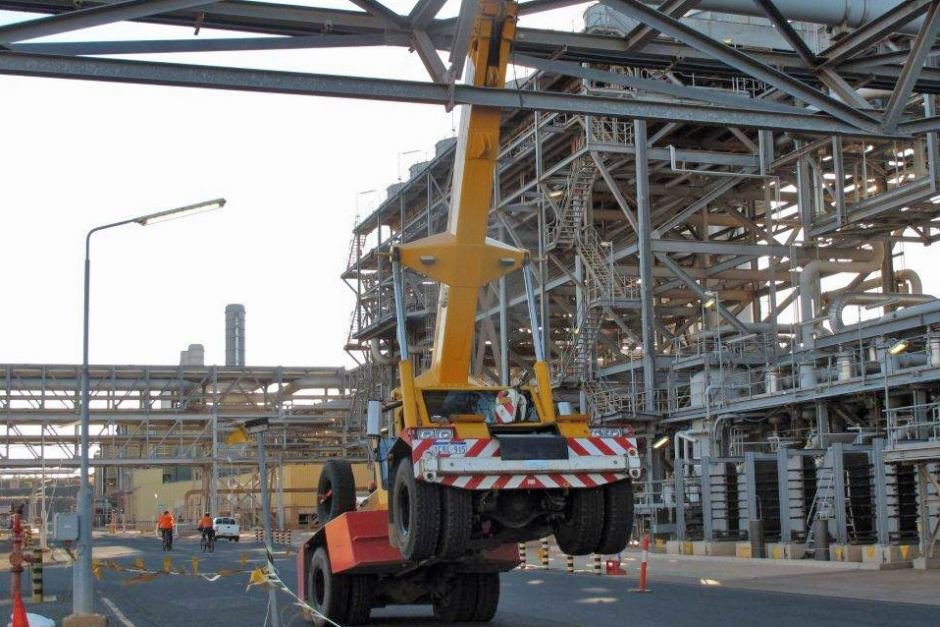Caught Between Hazards: One of Construction’s Fatal Four
8 min readTo reduce the high number of injuries and deaths that occur on construction sites, the Occupational Safety and Health Administration, OSHA, has identified the four most common causes of injuries and fatalities in construction. Known as the “Fatal Four” or the “Focus Four,” these hazards include struck-by hazards, caught-between hazards, fall hazards, and electrocution hazards. “Caught-in” or “caught-between” injuries occur when someone is caught, squeezed, pinched, or pinned between two or more objects. If not fatal, these incidents often result in crushing injuries such as broken bones, amputations, and asphyxiation. This program discusses the various caught-in and caught-between hazards that can be found on a construction site and the safe work practices that workers must follow to protect themselves from these dangers.
Topics include avoiding becoming caught between equipment or objects, the role equipment operators play in preventing caught-between injuries, avoiding excavation collapses, preventing caught-in rotating or moving part injuries, and avoiding being caught in collapsing structures.


Reading the Blog, you will be able to explain the following:
- What precautions to follow to avoid becoming caught between equipment or objects;
- What measures equipment operators can take to prevent mobile equipment-related caught-between injuries;
- How trench and excavation collapses occur and how to avoid them;
- How controlling hazardous energy and safe tool use can prevent being caught in rotating or moving parts of machinery;
- What safe work practices to follow to prevent becoming caught in collapsing structures.
BACKGROUND
- As a construction worker, you already know that the Jobsite can be dangerous. In fact, over 5,000 construction workers are killed and over 150,000 are injured each year.
- In an effort to reduce the high number of construction-related incidents, the Occupational Safety and Health Administration, OSHA, has identified the four most common causes of injuries and fatalities in construction.
- Known as the “Fatal Four” or the “Focus Four,” these hazards include struck-by hazards, caught-between hazards, fall hazards, and electrocution hazards.
CAUGHT-BETWEEN HAZARDS: One of the Fatal Four
- “Caught-in” or “caught-between” injuries occur when someone is caught, squeezed, pinched, or pinned between two or more objects. If not fatal, these incidents often result in crushing injuries such as broken bones, amputations, asphyxiation, and more.
- Some common examples of caught-in and caught-between hazards include:
- Being pinned between moving equipment and solid objects,
- Becoming caught in a trench or excavation collapse,
- Getting caught in rotating parts or moving machinery,
- Being caught in or trapped under collapsing structures or shifting materials
CAUGHT-BETWEEN EQUIPMENT OR OBJECTS
- There are a variety of ways workers can become pinned or caught between equipment or objects.
- They may be pinned between a piece of equipment and a solid wall; they might be pinned between two different pieces of equipment; they could get pinned between materials being stacked or stored near a solid object.
- You can prevent this by never placing yourself between any solid objects that could move, shift or be moved by others.
- If you do need to enter such an area, you should ensure that the objects cannot move on their own and also place a barricade around the objects to prevent someone else from moving the objects while you are in between.
- Another common caught-between injury occurs when workers are crushed between mobile equipment and a solid object.
- To prevent this, turn off vehicles and equipment before conducting repairs or maintenance; use wheel chocks to block the wheels and prevent the vehicle from rolling; lower the blades or forks on mobile equipment; and, never place yourself between moving equipment and stationary objects, such as a wall.
- When traveling around the Jobsite, make eye contact with equipment operators and wait for their signal before crossing their path.
(learn more: templatesmachine-safeguarding-program/)
EQUIPMENT OPERATOR RESPONSIBILITIES
- Equipment operators also have an important role to play in preventing mobile equipment-related caught-between injuries.
- First, always inspect your surroundings before moving any equipment.
- If barricades are required for the operation, make sure they are installed.
- While operating, try to follow a predetermined path of travel when loading, unloading, stacking, and storing materials. This allows other workers to be aware of the equipment’s travel path and stay clear.
- Never lift or carry loads that exceed the equipment’s capacity and make sure your load is secure and stable. Many caught-between injuries involve tip-overs or unstable loads.
- Of course, equipment operators must always wear their seatbelt. If the equipment does tip over, the seatbelt will keep the operator inside the safety cage or cab and prevent you from being crushed by the equipment.
- Also, any moving part of the equipment that could move or fall unexpectedly must either be fully lowered to the ground or securely blocked when being repaired or not in use.
(Learn More:heavy-equipment-top-10-safety-tips-for-incident-prevention/).
CAUGHT-IN A TRENCH OR EXCAVATION COLLAPSE
- According to OSHA, excavation workers are more than twice as likely to be killed on the job than any other type of construction worker.
- Unprotected trenches and excavations can collapse and crush or suffocate workers that are caught between shifting soil and solid objects or caught in and buried under the heavy soil as it collapses.
- Cave-ins most frequently happen when there is unstable soil, when too much weight is placed close to the side of a trench or excavation, or when water accumulates in the excavation.
- Trenches that are deeper than five feet, or those that are otherwise unstable, need to have protective systems in place such as sloping or stepping the trench sides, adding shoring and bracing, or using a trench box to protect workers from the risk of collapse or cave-in.
- Never enter a trench that seems to be unsafe. Every trenching or excavating operation must have a competent person to determine what type of protective system, if any, must be used in any particular situation.
- To reduce the risk of collapsing a trench, avoid running heavy equipment near the edge of any excavation when workers are inside; place all spoil at least three feet from the edge of the excavation; and, only enter or exit a trench or excavation by using a ladder, stairway or properly-designed ramp.
- Never take a chance with a trench or excavation. If you’re unsure, don’t go in.
(learn more: Trenching-and-excavation-safety/).
CAUGHT-IN ROTATING OR MOVING PARTS
- Just about every construction job site has machinery with moving or rotating parts. This equipment can cause serious injury if workers are caught in rotating or moving parts.
- Fingers, hands, and arms can quickly be pulled into moving equipment, as can any type of loose clothing or long hair.
- When guards are removed or equipment is being serviced or repaired, follow proper lockout/Tagout procedures before placing any body part into the danger zone of machinery or equipment that has moving or rotating parts.
- Lockout/Tagout procedures require that the power source be turned off, locked, and marked with a tag to indicate that the equipment must not be re-energized. This ensures that the equipment cannot start or move while being serviced or repaired.
- Tools powered by a single plug should be unplugged before changing bits or blades.
- The lockout/Tagout principles of controlling moving parts or hazardous energy also apply to mobile equipment while being serviced. Implement the use of jack stands to keep lifted vehicles from falling; place wheel chocks to keep equipment from rolling; and, place blocks or braces to keep hydraulic or pneumatic systems from moving or lowering.
- The use of unguarded tools or equipment is another common cause of caught-in injuries.
- Always inspect equipment before use and don’t use any equipment that is missing a guard.
- Report any unguarded equipment to your supervisor so it may be taken out of service and repaired.
- Also, do not remove or alter the guards on your power tools. The guarding on circular saws, grinders, and similar tools is a critical safety component of the tool’s design.
(Learn More:e-bookssafety-the-safety-professionals-expanded-guide-to-lockout-tagout/).
A READING FROM THE OSHA FILES
Construction Worker Testimonial:
“Our crew was installing an underground telephone line in a residential area. We had just finished drilling a hole under a driveway with a horizontal boring machine. We had pulled the boring rod out of the hole and someone straddled it and stooped over to pick it up before the rod had stopped rotating. It tossed him around pretty good, threw him on a pile of materials. He died later from his injuries.”
- The investigation into this caught-in incident revealed improper or inadequate guarding of the equipment with the employee’s loose clothing being noted as a contributing factor. All workers must understand the danger presented by moving or rotating parts and stay well clear.
CAUGHT-IN COLLAPSING STRUCTURES
- A construction site frequently contains structures that are in a partial state of assembly, disassembly, construction, or demolition. Scaffolding, shoring, walls, and objects supported by jacks are just a few examples of structures that could collapse onto workers below.
Scaffolding
- To help prevent this, OSHA requires that a competent person supervise the erection, dismantling, moving or altering of any type of scaffold.
- Scaffolding should also be inspected on a regular basis to determine its strength and integrity and marked with an inspection tag.
- Do not set up or remove scaffolding unless you are trained and authorized to do so. Also, do not climb on any scaffold unless it is tagged as having passed inspection.
- Scaffolding should be erected with solid and stable footing; all locking pins should be in place and closed and all required support bracing installed.
Demolition
- Construction workers have the potential to be buried and crushed by walls that collapse during demolition.
- According to OSHA, during demolition, stand-alone walls that have more than one story must have lateral bracing, unless the wall was designed to stand on its own and is otherwise able to be self-supporting.
- Also, it’s important to remember that jacks must have a firm foundation. When necessary, the base of a jack must be blocked or cribbed.
- After the load has been raised, it must be immediately secured.
- Finally, the materials used to shore or brace a trench can themselves become a collapsing structure hazard when installed improperly or if a support mechanism were to fail.
- Whether you are in a trench, under a scaffold, near a wall, or using a jack, be aware of the risk of collapse and take measures to protect yourself at all times.
SUMMARY
The caught-in or caught-between hazards we have discussed, such as workers being pinned against equipment, caught-in moving parts, or trapped under collapsing structures, are part of OSHA’s Fatal Four construction hazards that make up nearly 60 percent of all construction-related injuries and fatalities.
Don’t become one of these statistics or stories. Stay alert on the job site and follow safe work practices to protect yourself from the caught-in and caught-between hazards found on a construction job site



